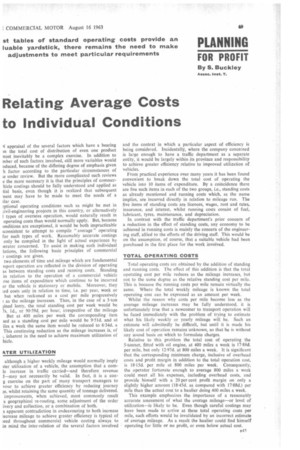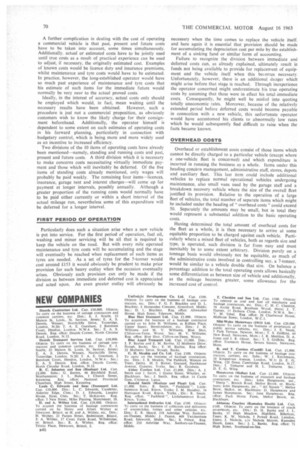Relating Average Costs to Individual Conditions PLANNING
Page 71

Page 72

If you've noticed an error in this article please click here to report it so we can fix it.
FOR PROFIT
By S. Buckley
Assoc. Inst. T.
4 appraisal of the several factors which have a bearing ut the total cost of distribution of even one product oust inevitably be a complex exercise. In addition to mber of such factors involved, still more variables would oduced, because of the differing degree of emphasis given h factor according to the particular circumstances of ;e under review. But the more complicated such reviews e the more necessary it is that the principles of commerhide costings should be fully understood and applied as tial basis, even though it is realized that subsequent nent may have to be made to meet the needs of a ;tar case.
[ptional operating conditions such as might be met in :ivil-engineering projects in this country, or alternatively I types of overseas operation, would naturally result in operating costs than would normally apply. But, because onditions are exceptional, it would be both impracticable [consistent to attempt to compile " average " operating for such types of work. Reasonably accurate costings only be compiled in the light of actual experience by [erator concerned. To assist in making such individual lations, the following basic principles of commercial ; costings are given, two elements of time and mileage which are fundamental Isport operation are reflected in the division of operating as between standing costs and running costs. Standing in relation to the operation of a commercial vehicle ose items of expenditure which continue to be incurred er the vehicle is stationary or mobile. Moreover, they ;ed costs only in relation to time, i.e. per year, week or but when reckoned as a cost per mile progressively [ as the mileage increases. Thus, in the case of a 5-ton ;ined lorry, the total standing cost per week would be ls. Id., or 90.59d. per hour, irrespective of the mileage But at 400 miles per week the corresponding • item sed as a standing cost per mile would be 9.51d. and at iles a week the same item would be reduced to 6-34d. a This continuing reduction as the mileage increases is, of inherent in the need to achieve maximum utilization of hide.
ATER UTILIZATION although a higher weekly mileage would normally imply der utilization of a vehicle, the assumption that a cornle increase in traffic carried—and therefore revenue 1—may not necessarily be valid. In fact, it is a cong exercise on the part of many transport managers to your to achieve greater efficiency by reducing journey ;e, whilst retaining the same quantity of tonnage delivered. improvements, when achieved, most commonly result a geographical re-routing, some adjustment of the order Avery and collection, or a combination of both.
s apparent contradiction in endeavouring to both increase tecrease mileage to achieve greater efficiency is typical of teed throughout commercial vehicle costing always to in mind the inter-relation of the several factors involved and the context in which a particular aspect of efficiency is being considered. Incidentally, where the company concerned is large enough to have a traffic department as a separate entity, it would be largely within its province and responsibility to achieve greater efficiency relative to improved utilization of vehicles.
From practical experience over many years it has been found convenient to break down the total cost of operating the vehicle into 10 items of expenditure. By a coincidence there are five such items in each of the two groups, i.e., standing costs as already mentioned and running costs which, as the name implies, are incurred directly in relation to mileage run. The five items of standing costs are licences, wages, rent and rates, insurance, and interest, whilst running costs consist of fuel, lubricant. tyres, maintenance, and depreciation.
In contrast with the traffic department's prior concern of a reduction in the effect of standing costs, any economy to be achieved in running costs is mainly the concern of the engineering staff, allied to the efforts of the driving staff. This would be on the assumption, of course, that a suitable vehicle had been purchased in the first place for the work involved.
TOTAL OPERATING COSTS Total operating costs arc obtained by the addition of standing and running costs. The effect of this addition is that the total operating cost per mile reduces as the mileage increases, but not to the same degree as the relative standing cost per mile. This is because the running costs per mile remain virtually the same. Where the total weekly mileage is known the total operating cost can be expressed as an amount per week.
Whilst the reason why costs per mile become less as the average mileage increases may be fully understood, it is unfortunately true that a newcomer to transport operation will be faced immediately with the problem of trying to estimate what his likely weekly or yearly mileage will be. Such an estimate will admittedly be difficult, but until it is made his likely cost of operation remains unknown, so that he is without any sound basis on which to formulate charges.
Relative to this problem the total cost of operating the 5-tonner, fitted with oil engine, at 400 miles a week is 17-88d. per mile, but only 12.97d. at 800 miles a week. It is significant that the corresponding minimum charge, inclusive of overhead costs and profit margin in addition to the total operation cost, is 18.154. per mile at 800 miles per week. Consequently, the operator fortunate enough to average 800 miles a week could meet all his expenses, including overhead costs, and provide himself with a 20 per cent profit margin on only a slightly higher amount (18-45d. as compared with I7.88d.) per mile than the actual cost to a haulier doing 400 miles a week.
This example emphasizes the importance of a reasonably accurate assessment of what the average mileage—or level of utilization—is likely to be. Even though careful costings may have been made to arrive at these total operating costs per mile, such efforts would be invalidated by an incorrect estimate of average mileage. As a result the haulier could find himself operating for little or no profit, or even below actual cost.
A further complication in dealing with the cost of operating a commercial vehicle is that past, present and future costs have to be taken into account, some times simultaneously. Additionally, actual or estimated costs have to be jointly used until true costs as a result of practical experience can be used to adjust, if necessary, the originally estimated cost. Examples of known costs would be licence duty and insurance premiums, whilst maintenance and tyre costs would have to be estimated. In practice, however, the long-established operator would have so much past experience of maintenance and tyre costs that his estimate of such items for the immediate future would normally be very near to the actual proved costs.
Ideally, in the interest of accuracy, actual costs only should be employed which would, in fact, mean waiting until the necessary results have been obtained. However, such a procedure is just not a commercial proposition, as obviously customers wish to know the likely charge for their consignment beforehand. Additionally, the operator himself is dependent to some extent on such estimates of operating costs in his forward planning, particularly in connection with budgetary control, which is being more and more widely used as an incentive to increased efficiency.
Two divisions of the 10 items of operating costs have already been mentioned—namely, standing and running costs and past, present and future costs. A third division which it is necessary to make concerns costs necessitating virtually immediate payment and those which will inevitably be deferred. Of the five items of standing costs already mentioned, only wages will probably be paid weekly. The remaining four items—licences, insurance, garage rent and interest charges—will come up for payment at longer intervals, possibly annually. Although a greater proportion of the running costs would normally have to be paid either currently or within a short interval of the actual mileage run, nevertheless some of this expenditure will be deferred for a longer interval.
FIRST PERIOD OF OPERATION
Particularly does such a situation arise when a new vehicle is put into service. For the first period of operation, fuel oil, washing and minor servicing will be all that is required to keep the vehicle on the road. But with every mile operated maintenance and tyre costs will be accumulating and the stage will eventually be reached when replacement of such items as tyres are needed. As a set of tyres for the 5-tonner would cost around £153 it would obviously be prudent to make prior provision for such heavy outlay when the occasion eventually arises. Obviously such provision can only be made if the division as between immediate and deferred cost is appreciated and acted upon. An even greater outlay will obviously be necessary when the time comes to replace the vehicle itself. and here again it is essential that provision should be made for accumulating the depreciation cost per mile by the establishment of a sinking fund or similar form of accounting.
Failure to recognize the division between immediate and deferred costs can, as already explained, ultimately result in funds not being available to provide for replacerrent of equipment and the vehicle itself when this becomes necessary. Unfortunately, however, there is an additional daager which might arise before that stage is reached. Through inexperience the operator concerned might underestimate his true operating costs by assuming that these were in effect his total immediate costs. Consequently, he might well be misled into quoting totally uneconomic rates. Moreover, because of the relatively extended period before deferred costs would become payable in connection with a new vehicle, this unfortunate operator would have accustomed his clients to abnormally low rates which he would subsequently find difficult to raise when the facts became known.
OVERHEAD COSTS
Overhead or establishment costs consist of those items which cannot be directly charged to a particular vehicle (except where a one-vehicle fleet is concerned) and which expenditure is incurred in running the business as a whole. Items under this heading concern management, administrative staff, stores, depots and auxiliary fleet. This last item could include additional vehicles to replace normal operational vehicles undergoing maintenance, also small vans used by the garage staff and a breakdown recovery vehicle where the size of the overall fleet justified its provision. Relative to the operation of a large fleet of vehicles, the total number of separate items which might be included under the heading of " overhead costs" could exceed 50. Separately the amounts may be small, but in total they would represent a substantial addition to the basic operating costs.
Having determined the total amount of overhead costs for the fleet as a whole, it is then necessary to arrive at some equitable proportion to be charged against each vehicle. Particularly where a mixed fleet of vehicles, both as regards size and type, is operated, such division is far from easy and must inevitably be to some extent arbitrary. Division purely on a tonnage basis would obviously not be equitable, as much of the administrative costs involved in controlling say, a 7-tonner, would be similar to a vehicle double that size. On balance a percentage addition to the total operating costs allows basically some differentiation as between size of vehicle and additionally, as the mileage becomes greater, some allowance for the increased cost of control.












































































































